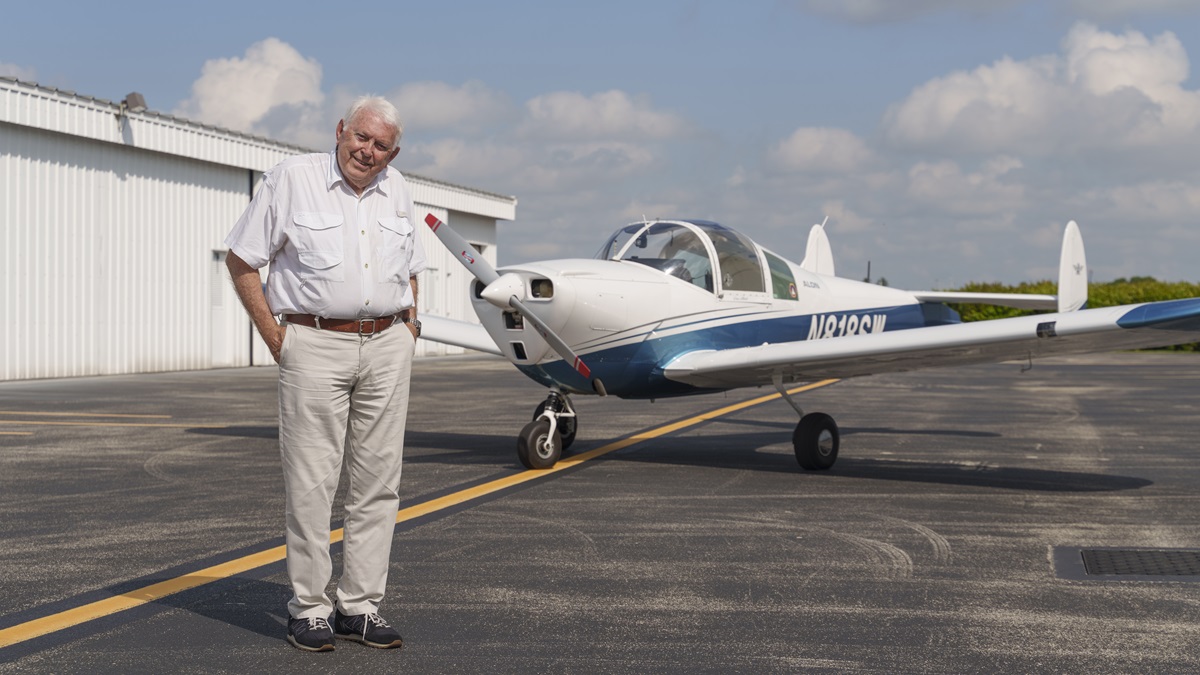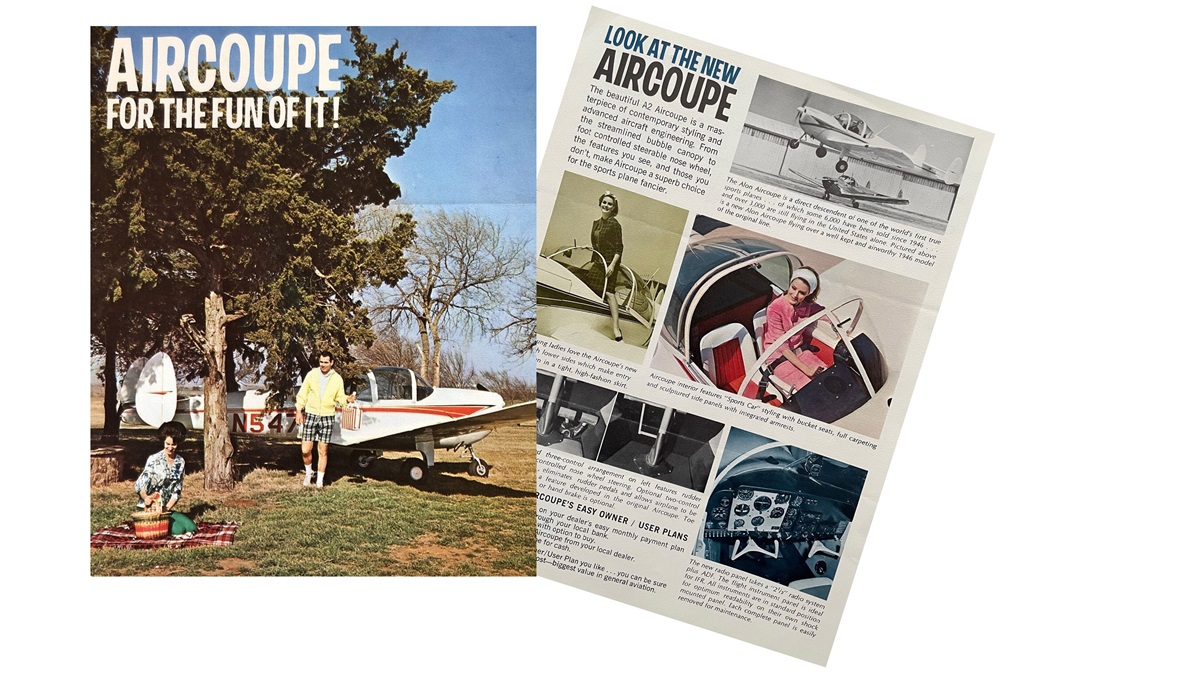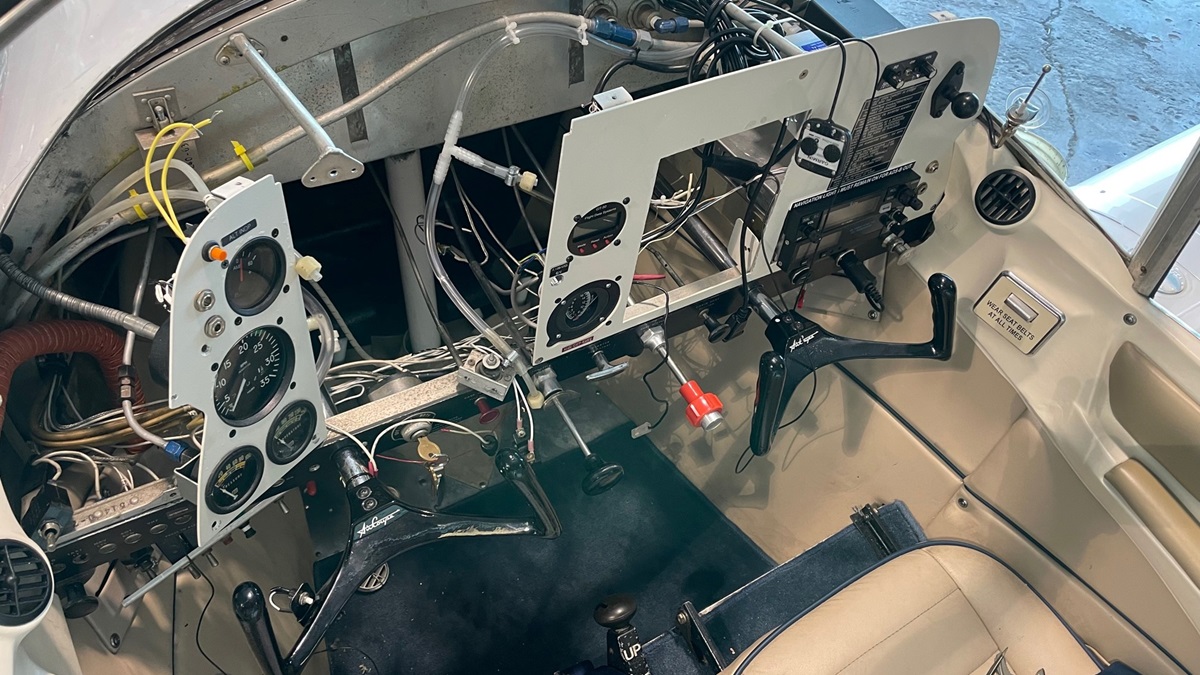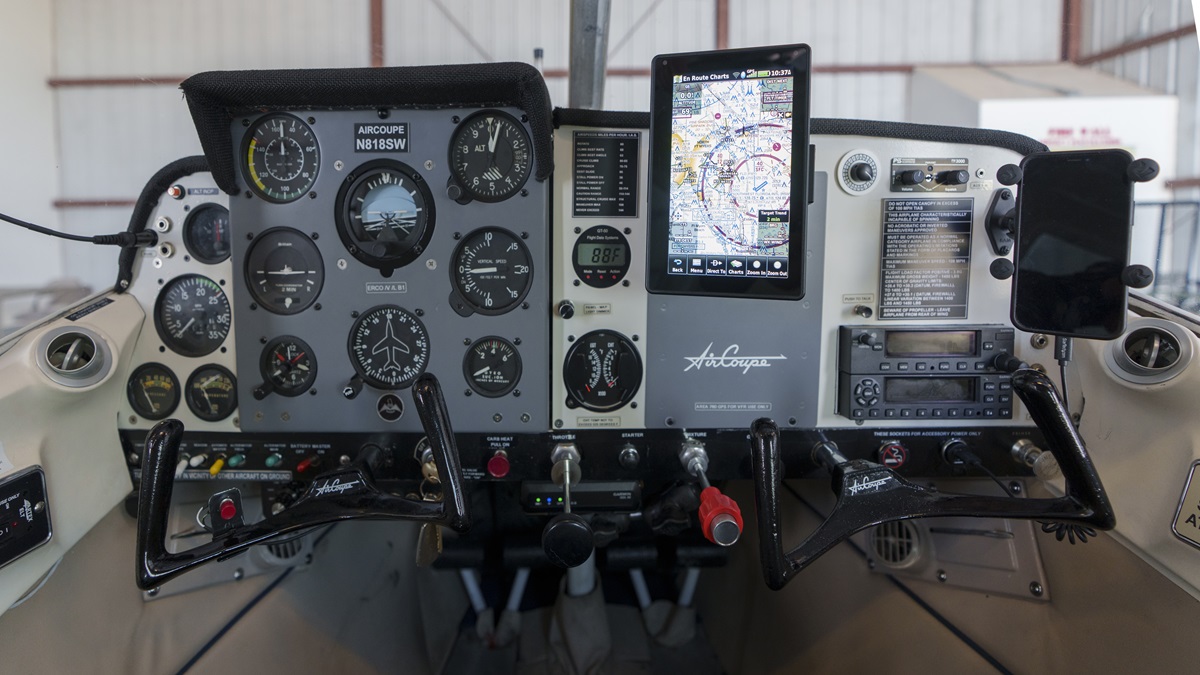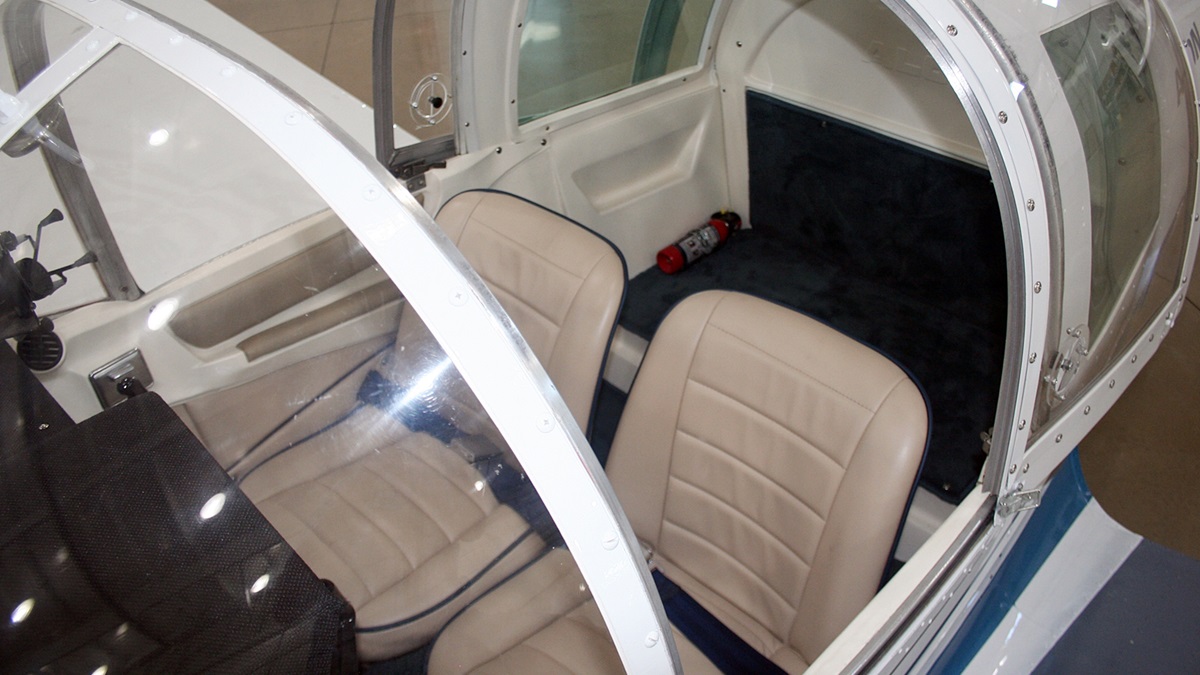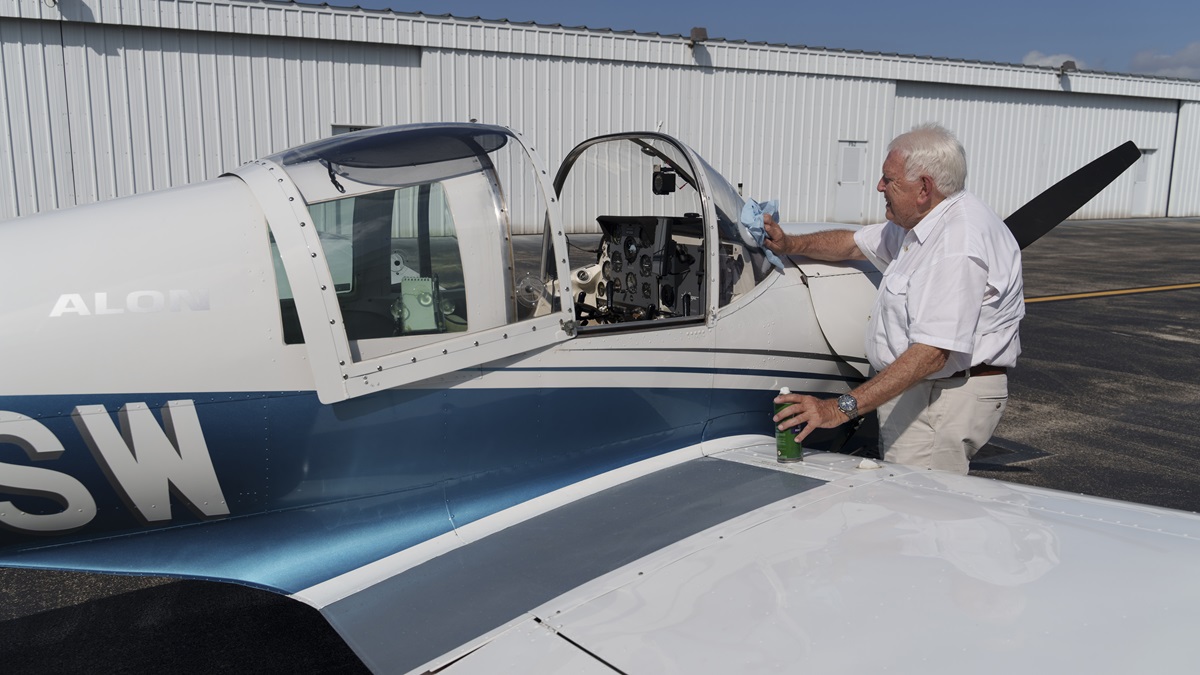For the fun of it
The bumpy road to carefree flights in the MillionAircoupe
By Don Abbott
Aviation has been part of my life for almost 60 years. Until recently, I flew a fully equipped, air-conditioned Beechcraft Bonanza F33A for business and pleasure.
Unfortunately, the aviation insurance industry has decided not to write policies for 70-plus-year-old owners of retractable gear aircraft. That forced me to put the Beechcraft up for sale. Retired from business, I really no longer need to fly 400-mile trips, in marginal weather, ending in an IFR approach to minimums. My new mission is to fly for fun, out to breakfast or lunch with the guys, or to attend fly-ins and airshows within 150 miles or so. I just want to fly. As the headline on an old Aircoupe brochure suggested, “for the fun of it!”
How many times have you heard, “If they only still made the Globe Swift, or the Stinson Station Wagon I would buy one today?” That is the way I feel about Ercoupes and Aircoupes. Having owned five assorted models of these little sports cars with wings, I began to search for my sixth, a 1960s Alon model. These airplanes differed greatly from the original post-war, two-control Erco versions. Among many updates were metal wings, a sliding canopy, large baggage compartment, toe brakes, and pedals for rudders and nosewheel steering. A Continental C90-16F engine produced improved takeoff distance, rate of climb, and airspeed. The last 50 Alons featured a spring steel main landing gear and an increase in gross weight.
After searching online for several months, I found a low-time A2 Aircoupe in Ohio with OK paint, upholstery, and radios. My plan was to make it good as new. A project of this nature would take a lot of time, patience, and perseverance—not to mention a pile of money. With a deposit made, I tracked the delivery flight to Florida on FlightAware. After a fuel stop in Virginia, I waited to see a takeoff. There was none. I got a call from the owner who told me, “On landing, the steering gave out and the plane flipped over. It is totaled.” Fortunately, the pilot escaped with only a scratch or two. So, it was back to the drawing board. I thought I had struck the mother lode when I saw an ad for a 1968 Alon A2A for sale by a dealer in Oklahoma. The company had transformed a faded red and blue N5479F into a real beauty with a new N818SW identity prominently displayed on a three-color Jet Glo paint job.
The ’coupe featured a fresh leather interior and a fair package of consignment store avionics. The only drawback was the asking price of $45,000. I laid the thought of owning it aside, but it just kept coming back, from 2 a.m. till daybreak. The next morning, I waited until one minute past opening hours and called the dealer, only to hear disappointing news. Someone else had bought the airplane. My airplane! I thanked him and suggested that he keep my number on file in case the deal fell through, or he came across another cream puff.
About a week and half later the dealer called me back. He said the buyer had encountered some problems that would prevent his purchase. Looking back, I wish I had investigated what was behind those “problems.” At any rate, I said I was still interested and asked about a pre-buy inspection. I was told one had been conducted for the man who had to back out. The dealer said the mechanic who had done the pre-buy was on vacation and his findings would not be available until he returned in a week or so, but the airplane had passed with “flying colors.” A momentary case of color blindness must have kicked in. I told him I would send earnest money to hold the ’coupe, but the full purchase might be held up because I was about to put my Bonanza on the market. He suggested a trade and asked me to send the Bonanza specs to him.
In a couple of days, we exchanged a virtual handshake. My only caveat was that the ’coupe would be delivered to Fort Myers, Florida. The whole deal was orchestrated by a title and escrow service and went well—until the last day. The agent said there was a “cloud” on the title of the Aircoupe. A previous seller had used a wrong owner designation on the bill of sale. Because the airplane had already passed on to several other owners since the error, I hesitantly agreed to move forward. I later discovered that the person who signed the original (erroneous) bill of sale had died in 1997. A daughter of the deceased offered to sign an amendment to the original bill of sale. It was filed with the FAA, and I was told the matter would be cleared up in due time.
Late September 2021, Alon N818SW arrived at Page Field (FMY). At first glance it was as advertised, except for a conspicuous wrinkle at the end of the right aileron. I looked in the logbooks to see if there was a mention of it, to no avail. A friend of mine once said, “When someone says there is no damage history, that probably means nothing was written down.” I was going to learn that lesson in short order.
The pilot handed me a piece paper with a list of squawks he experienced during his two-day flight to deliver the aircraft. First was a loud whistle coming from somewhere around the canopy. Second, the fresh air vents were inop, which is not good in Florida. These items were followed by news of a couple oil leaks, a shimmy in the nosewheel, a jumpy altimeter, a slightly tilted artificial horizon, a questionable airspeed indicator, and a wandering directional gyro. The paint job must have rendered me temporarily insane because I was convinced that these squawks were all minor issues. I shook hands with the ferry pilot and wished him a safe flight as we exchanged keys. I must admit, I sniffed back a couple of tears watching the Bonanza fly west. We had a good 14 years together.
The following week, I took 8SW to Roger Smith at Carter Aircraft in Sebring, Florida, for a post-buy inspection. First on the multiple-item punch list was the repair or replacement of the right aileron. Fortunately, I was able to find a like-new one at a fair price.
I found a low-time A2 Aircoupe in Ohio with OK paint, upholstery, and radios. My plan was to make it good as new. A project of this nature would take a lot of time, patience, and perseverance—not to mention a pile of money.Under Smith’s supervision, I removed the instrument panel and proceeded to make sense of the rat’s nest of added and not-so-subtracted wiring. Several modifications to the panel were made to accompany new instruments and radios, including replacement of worn upper and lower instrument panel shock mounts and a new paint scheme.
During several flights I had noticed a significant engine vibration between 1,900 and 2,300 rpm. The most annoying problem was the tendency for the aircraft to enter a 20-degree bank to the left when the controls were neutralized. I decided to contact my friend, nationally known ’coupe expert Lynn Nelsen, for his experienced hand at the rigging.
I asked him to give my new baby the once-over for anything that might require attention to bring the airplane up to standards. A careful scan of the logbooks revealed several extended periods when the airplane did not fly, along with sketchy annual inspections and compliance with airworthiness directives and service bulletins. He noted that the engine had been overhauled, not once but twice, and the control systems were last lubricated five years ago. Several oil and exhaust leaks were found, which could have been attributable to worn piston rings. The engine had only 500 hours since major overhaul, but that was 16 years ago. Nelsen pointed out that ring/piston wear causes excessive blow-by, creating not only a mess, but also excessive internal pressure in the engine.
Nelsen’s powerplant expert Jeff Biter came on board to install new rings and give the engine a thorough inspection. When the cylinders were removed, he discovered that at least two of the valve tappets showed spalling, which could cause uneven wear on the camshaft, if it had not already. He said, in addition to replacing the tappets, the camshaft might need to be reground or replaced. Biter split the engine case for a more detailed inspection, which revealed a host of problems including two cylinders out of round and two beyond repair. Time for a top overhaul.
The following is a partial list of work accomplished by Nelsen and his son over the next three months:
- Overhaul nose gear with new bushings, internal and scissor parts.
- Replace damaged carb heat box, missing baffles for the oil tank and starter, baffle clips and springs, a tail pipe hanger, and a worn exhaust bracket.
- Replace scat tubing, hoses, clamps, and all nonstandard hardware.
- Detail engine compartment.
- Properly orient fuel pump and install new fuel lines.
- Replace missing canopy latches.
- Repair cowling, add chafe strips.
- Remove and reinstall engine and propeller.
While waiting on the engine to be finished, Nelsen suggested that the prop should be sent out for inspection and service. He added I might want to have it re-pitched as a cruise prop to gain some extra speed. I thought that would be a good choice, so off it went to Aircraft Propeller Works in Auburndale, Florida, for a makeover.
The day finally came for a series of test flights during which Nelsen carefully noted any items that needed tweaking. Adjustments were made to wing trim, mixture, and throttle, and then everything was to his satisfaction. After being apart for 83 days, Eight Sierra Whiskey and I finally headed home. We laughed and sang very loud—all the way. It was a really good feeling.
The bumpy road to restoring and updating 818SW took hundreds of hours over five months. Indeed, there were lots of unknown expenses and many costly new additions, but Eight Sierra Whiskey turned out to be a one-of-a-kind aircraft. With all the work completed, I have been enjoying many flights “for the fun of it” including lots of fly-out breakfasts and a recent visit to Sun ’n Fun.
No matter where I go, the Million Aircoupe draws a crowd. Several people have asked me about the Mooney logo on the tail of the airplane. Alon sold the rights to the Aircoupe to Mooney in 1968. According to the ID plate 8SW was one of the few built by the Alon Division of the Mooney Aircraft Corporation. To me it is like owning a new airplane—but then that was the plan all along. 
Don Abbott is an instrument-rated, commercial single- and multiengine pilot. He has been a member of AOPA since 1964 and earned the Wright Brothers Master Pilot Award in 2011. As a television producer, Abbott wrote, directed, and narrated a documentary titled The Ercoupe Story, Fearless Flying.
